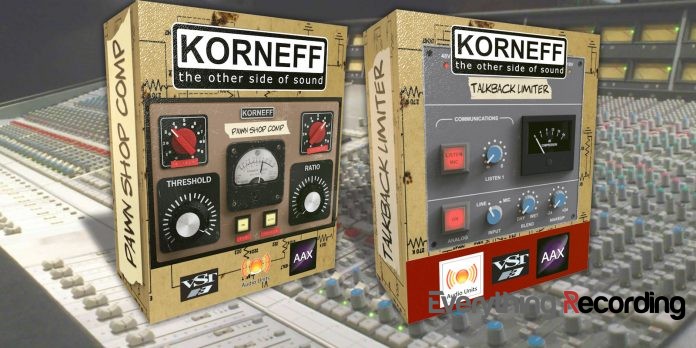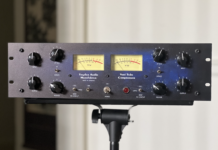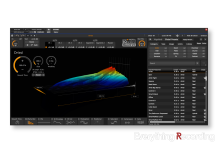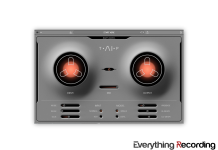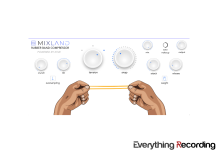It’s become more and more common to see producers and engineers lend their name and signature sonics to plug-ins. Chris Lord-Alge still leads the pack – and we’re not going to be surprised the day we find a bottle of CLA Edition Windex in our mailbox. But notable other non-Lord-Alges have gotten in on the game, too – be it for their take on signal processing, drum samples or amp tones.
Producer and engineer (and fellow New Yorker), Dan Korneff (Breaking Benjamin, My Chemical Romance, Paramore and dozens more) recently took things a step further by not only releasing two “secret weapon” compressor plug-ins, but doing so from his own company, Korneff Audio. With their new Talkback Limiter and new-and-improved Pawn Shop Compressor 2.0 plugins loaded up, let’s see how good the “lovin’, touchin’ and squeezin’” gets.
(And yes, I just referenced Journey lyrics. Have your mom explain them to you.)
COMPRESSORS, COMPRESSORS EVERYWHERE
Installing a new soft-compressor in my studio doesn’t conjure the excitement it once did. Hardware? Yes, all day long. But here at ER, we’ve reviewed a LOT of the compression plugins out there. Like… a lot a lot.. And where my VST folder once had just about every single one under the sun, I’ve since dialed it back to a much shorter list. Choosing a compressor used to mean losing momentum to surfing 100 compressor options. I one day realized that, despite all of their different graphics and supposed emulations, most of them sounded pretty much the same. I cleaned house and my workflow improved considerably.
So anything that’s going to be sticking around either needs to be a solidly reliable option that does its reliably solid thing – OR – it has to offer something ‘special’, something truly unique – much the way I love having a hardware version of a Shure Level-Loc or a Valley People Dynamite. There’s just something that those “do” that I can’t tug out of any other compressors – software, hardware or otherwise.
ONE PRACTICAL. ONE RADICAL.
Engineers tend to engage compressors for two entirely different reasons. The “traditional way” is to smooth irksome peaks in the dynamics, letting you bring up the overall RMS level between them. More and more, engineers these days use them to add some grit, punch and energy to a track. Obviously the process is the same, but the TYPE of compressor you use and your approach to using it lends itself to certain results. For example, if you wanted to gently roll of some peaks and bring out the space between the notes, you would likely reach for something a tad more polite, say, a Focusrite Red 3 or a GML 8900. Both are incredible pieces of engineering, but lean very “proper”. The way I’m hearing compressors used now is more “destructive”. It’s more common to see an 1176 compressor pushed hard and with all buttons in, yielding a barking thwack with a healthy dollop of harmonic distortion.
The Pawn Shop Compressor 2.0 is conceivably able to do both – although again, I anticipate most will use it more for the latter. In terms of sheer options and flexibility, this might just be the most tricked-out and customizable comp I’ve ever seen. Not only does it combine several of the high points from several different vintage circuits, but gives you insane amounts of control over what’s going on (literally) under the hood. The Pawn Shop is truly the tone-tweaker’s paradise, providing options upon options to customize the individual pieces, letting you unlock hundreds of potential uses. Look, it’s like Bisquick. You can make pancakes, muffins, biscuits, quiche, and about a million other kinds of breakfast.
Meanwhile, The Talkback Limiter gives you easy access to the sound of classic “Listen Mic Compressor” originally found aboard the Solid State Logic 4000 console. This circuit was never intended to become a classic, it was a simple ∞:1 ratio design to allow a talkback microphone to be heard from any corner of the live room. The story of its accidental discovery is fairly well published (but would involve mentioning Phil Collins – which is an automatic 7 years of bad luck) – and since its original 1980’s reign, it still reappears now and again with it’s unique, smashed dynamics. And it definitely bears the “compressor as an effect” designation.
DOWN HERE AT THE PAWN-SHOP
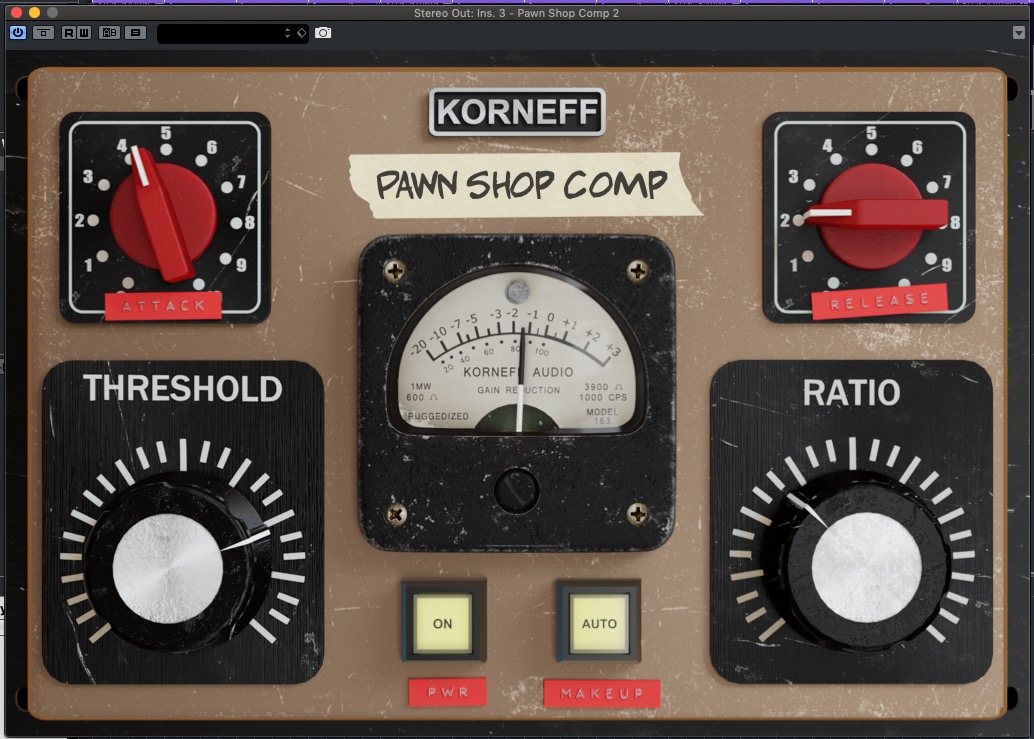
Unlike many vintage-styled plug-ins, the Pawn Shop Compressor is more of a Frankenstein of Dan Korneff’s own imagination and not an attempt to recreate a piece of vintage outboard. That makes reviewing it a tad different than the latest emulation as we’re not simply asking “How much does it sound like the AudioCorp ThingyDo 3920”? The Pawn Shop Comp is a unique beast unto itself. And what a beast it is.
First of all, let’s look at the block diagram here. You’ve got a tube-modeled preamp and two-band eq (separated into “weight” at 63 or 171hz and “focus” at 1.6 or 2.4kHz) on the front feeding the FET-modeled compressor circuit. Post-compressor you’re given the choice between iron, nickel or steel transformers (we’ll let Peterson from DIYRE explain) and a wet/dry control. But between the way in and the way out there’s quite a lot of component-level customization. It’s the first plug-in to come with a soldering iron and a Mouser account, basically.
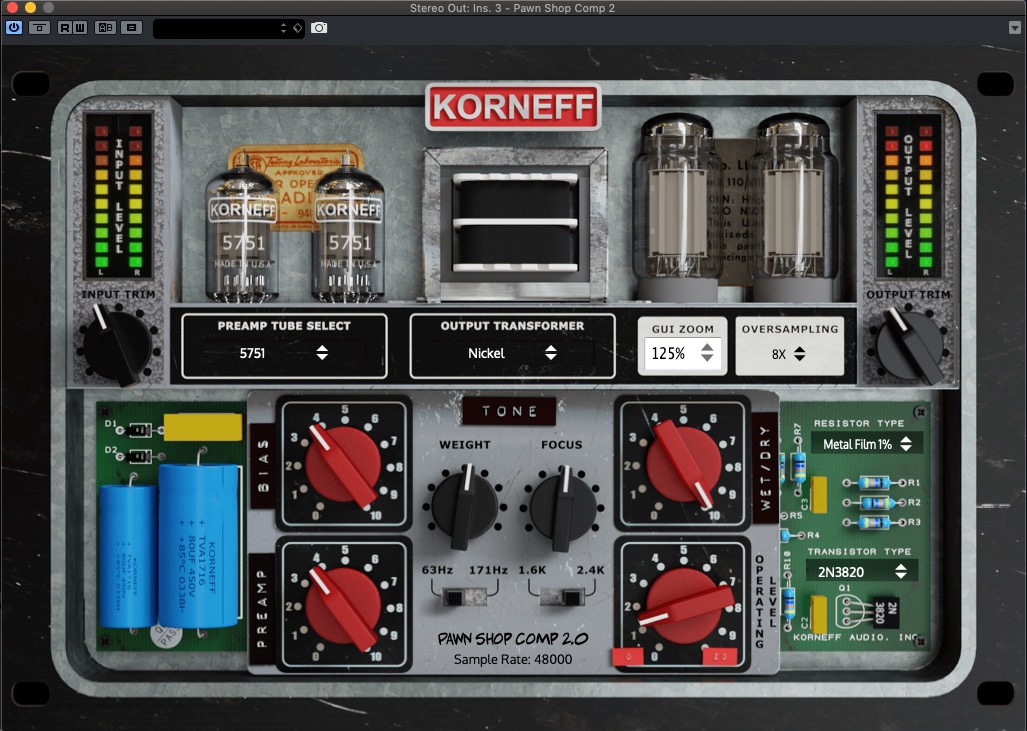
A lot of the options you’ll see under the hood of the Pawn Shop Comp assume a fair bit of “traditional” audio engineering knowledge. Before the turn of the millennium, it was expected that an audio engineer would not only be able to handle miking, recording, mixing and so on… but also tackle the troubleshooting and maintenance of the studio’s console, wiring, and outboard. But we’re also working off the DIY mindset here – where builders and engineers know the subtle differences between say… a MAT-12 or SSM2019 transistor. Or differences between the material and tolerances of resistors. And lest anyone cry “Gimmickry!”, this plug-in’s creator is a guy who really likes building his own gear (I’ve not used one personally, but I’m told his 1176 clone is very, very well-made).
It’s truly a lost art and I will never stop encouraging even the most in-the-box of engineers to learn the basic principles of electrical engineering, join GroupDIY (it’s like GearSlutz for DIY audio, minus the cult mentality) or even maybe design and build themselves a piece of gear someday. But I also acknowledge that times have most certainly changed and nowadays I’m impressed when people can solder their own cables. With that said, it doesn’t mean those not possessing this arcane knowledge can’t use or enjoy the options herein – in fact, it might just be the sort of thing that piques your interest to learn more about the actual circuits and their behavior.
The Pawn Shop Compressor 2.0 offers so many different component-level choices, letting you substitute not only “the big stuff” like tube types (with adjustable biasing) and transformer core material, but types of resistors and transistors in the compressor circuit. If you’re looking for a way to join polite conversation at the next AES cocktail hour, this might just be your ticket. And if you’re self-aware enough to say, “okay, look, I have NO idea what any of this crap means”? Well, start switching stuff back and forth and learn a thing or two.
SONICS > GADGETS
It doesn’t matter if you know how or why to swap Panasonic capacitors for WIMAs – or the benefits of using a half-wave rectifier diode. A plug-in is only as good as it sounds and Pawn Shop Compressor 2.0 sounds quite good. Really good. It’s the toaster that gets you the perfect done-ness between golden-brown edges and burnt-to-a-damn-crisp. What’s even better is that, with so many presets and settings to use different parts of its signal flow – it’s extremely versatile. Even with the compressor itself switched out, the tube preamp and EQ can add some Ron Jeremy-esque girth – or you can simply engage the output transformers for some nice subtle harmonic sweetening.
Using the tube preamp stage to light up the upper bands of a ho-hum drum mix, I was struck by how well the cymbals and room mics were now “sitting right”. Pushing the compressor deeper and deeper into the mix, their presence managed to delicately straddle the line between “too loud” and “right there”. Okay, good on drums, check. Clicking it in on a submix of backup vocals (that I had been agonizingly doing pass after pass of automation for), I instantly fell in love with the way it seemed to glue eight different voices into a single element. Plosives were neatly tamed and the overall presence of the group became much more apparent.
I’ve whipped up a couple of settings (stored as ‘Beef Machine’, ‘Beef Machine II’ and ‘Beef Supreme’) that really, really seem to like my bass guitar playing. I used the Pawn Shop’s “focus” setting on the preamp to goose out the harmonics and let the compressor clamp down on dynamics with a fairly slow attack and quick release, aggressive ratio (8:1) and threshold taking out maybe 8db on hard peaks. The result with the distortion out evokes the classic sounds of Tool’s first couple of records. Step on the virtual distortion pedal of your choosing though and every pick scrape on the notes’ attacks carved out a perfect little “sha-shonk” before the compressor got to it, and the weight of the lows collapsing back in on themselves post-attack gave the bass tremendous space in the mix without ever feeling too present or brash.
Sonically I’m reminded of a few different pieces of analog gear here, depending on usage. Though I suspect the 1176 was a big influence, I heard shades of both the Drawmer 1969 and Empirical Labs Distressor with the compressor working. Neither of those are bad crayons to color with! You can get the compressor pushed pretty far (about 9db of GR) before its grunting and pumping become too apparent. Obviously this is source dependent, your mileage may vary, etc. etc. etc.
But this is where I wanted to really see what taking my virtual soldering iron to the insides would do. With three types of tubes and output transformers, I could definitely sense the different dimensions that each of these offer (to the lesser-initiated, these are subtle. Switching from iron to steel transformer cores is not a huge revelation. Again… it’s subtle…). Better yet, a little fussing with the transistors in the compressor’s block really opens up different shades, tones and colors. Even if you’re not totally sure what you’re swapping or why, chances are if you try enough combinations you’re going to find “that sound”. Make sure to save the preset.
I’m impressed with the Pawn Shop Compressor’s ability to do a little or a lot. As a utility infielder, you can sprinkle just a bit of analog-modeled magic dust onto tracks or groups that are otherwise just coming up “meh”. But shift gears into “spank it” territory and your once-tamed animal now seethes with rabid aggression. You want to get gnarly with it? Happy to. One thing I appreciate about the Pawn Shop is that their switchable innards gives you something you simply can’t do with hardware (unless you somehow devised a robotic lazy susan that would swap in all the different pieces).
My standard “I can’t believe I have to say this, but apparently I do” caveat here: As with ALL compression, it’s important to temper your results against the whole mix and not just the soloed track. And try not to get a god complex with your ability to make everything loud. Compression is not an ingredient, it’s a spice. Use accordingly.
I CAN HEAR IT IN THE AIR TONIGHT
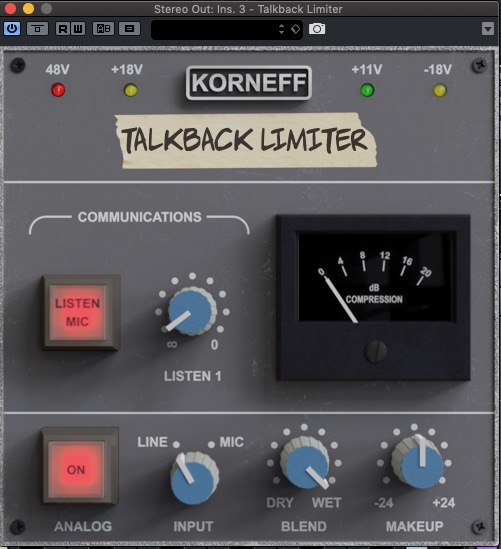
Switching over to the Talkback Limiter, I had high expectations and preconceived notions. Having not only done “that actual trick” on “that actual console”, but coming dangerously close to purchasing the 500 Series circuit from SSL themselves multiple times, I know and love what the SSL “LMC+” (Listen Mic Compressor) does to just about anything you want to throw at it. A word of caution, using this plug-in is kind of like “the teen movie slow clap” – there’s a time and a place for it, choose wisely.
It’s hard for mankind to conceive of something “beyond infinity”, but that’s the compressor ratio here. In a fully quiet room with the monitors up, it can hear your thoughts (and frankly, it’s a little concerned). The ability to make the quietest whisper as loud as the end of times is a compression effect that can be deployed to create suspense or surprise in a mix – again, provided it’s used properly.
YOUR NEW SONIC CRUSH
What’s really going on here is just that – a bazillion-to-one compressor with 30db of gain and a devil-may-care attitude towards actual fidelity. Sonically it’s not dissimilar to the classic Shure Level-Loc – any voltage that dares cross its threshold is savagely beaten into a flattened pulp (kind of like when engineers first got their hands on Ozone). And if Dan & Co. never thought to allow you the opportunity to peel back the faceplate and tweak the innards, it’d still be a very worthwhile plugin to have at the ready.
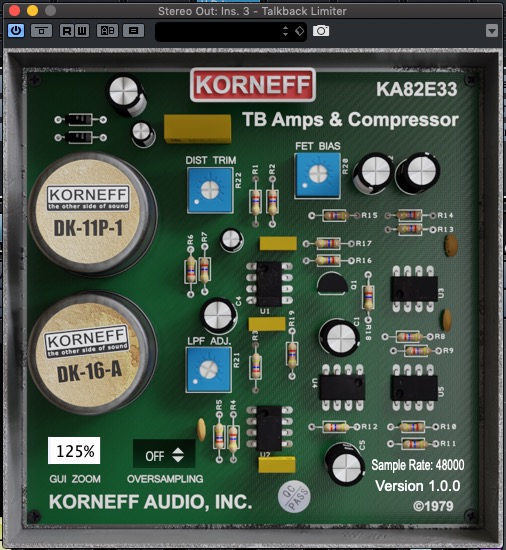
But as a well-regarded analog circuit designer himself, Dan Korneff wants you to get your hands dirty. Flip the lid and now you have an array of customizations that all impart a slightly different characteristic upon the results. Below deck, the Talkback Limiter allows you to apply a low-pass filter or tweak the amount of distortion to modify the compressor’s output – letting you really make things snarl if that’s the sound you’re going for. Again, let’s not try and paint the Talkback Limiter as a versatile, transparent, gentle sort of thing here. It’s downright brash on its good days, but if that’s the effect you’re looking for, you’ve found it.
As far as its ability to ‘do that thing’, yes it most ably does. Dynamic drum mixes are squashed like bugs. Vocals are put nose-to-nose with the listener. It’s fantastic as a send effect for brief “a-ha” (no, not this a-ha) moments in the mix, or to provide an extra layer of sonic aggression to really drive the point home. If you’re remastering an old orchestral performance for the old lady down the street, leave this one alone. (Also, don’t forget to click the 11v LED to simulate that power rail being out. Nice touch.)
A favorite use of mine is to use something like this as a parallel effect on its own fader instead of twiddling the wet/dry blend internally. Across a drum bus, you can automate levels in during less high-volume parts of a song where it provides just the right amount of nuance. Of course, that effect also works in reverse when you fade it up on fills or loud sections to help that part of the track really charge ahead.
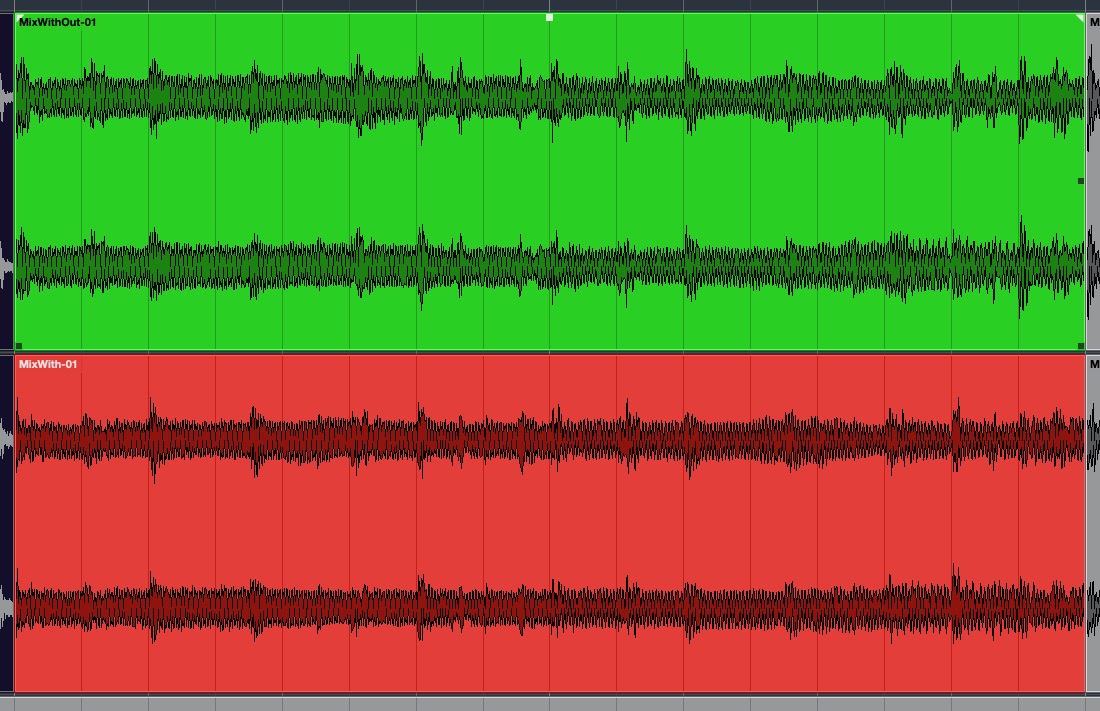
HIGH MARKS AND A COUPLE OF LOW NOTES
We haven’t had an opportunity yet to discuss just how excellent the actual interface of these plugins are. They are well-realized and intuitive – making you really want to get in there and play around with all the parameters. What’s more, they’re resizable, which (are you hearing me, everyone else?) makes working with them alongside everything else on your cluttered screen possible (instead of Command-~-ing your way through window after window after window.
Another thing we haven’t discussed yet is the clever inclusion for both plugins to adjust the oversampling. Goosing the Nyquist multiplier can help ensure smooth output, lessen signal-to-noise and avoid phase smearing or distortion. But that can and does come at the cost of CPU-cycles. Both plugins allow you to bring that number down if your available resources are dwindling – or if you just want to throw caution to the wind and invite more demons into your 1’s and 0’s.
Kudos again for the wet/dry knobs. It seems that just now even analog devices are coming around to the idea of using one box to do a parallel mix without taking up real estate. Yes, you can always do the effect as a send and blend that way (plus easy automation of the two to make your mix dynamic), but that’s not always necessary. Just twist one knob and you’re done.
Two sticking points of note for me. For one, no sidechaining (either internal HPF or externally-sourced) is a bummer. With compressors, bass drums and low notes can create a pumping effect on the overall result that makes the compression obvious, and not in a good way. Hi-passing those kicks and subs out of the detection circuit will leave the lows the space they need without the rest of the mix being pushed out and falling back in on every note. Same goes for external sidechaining. With plugins that can get this grungy, being able to engage them with other sources as the trigger opens a whole new vista of creative options*. I just find it odd that these plugins are built to be customizable with such finite precision in one regard, but lack these two important features.
(*You can always create duplicate outputs for whatever you want to use this on, set up your own crossover frequencies so there’s a low and high fader then apply the plug-in to the high channel only – then sum them both back into a new output. It’s not hard, but it does take some extra fiddling.)
The second – on the Talkback Limiter – was how difficult it was to nail the sweet spot with gain values. Even though range would go from a scale of 30db, the actual range between creating “none” and “way too much” would be between fractions of a single number. For example, 10.2db of input gain would be next-to-nothing, but 10.5db would leave your audio bleeding out on the side of the road. You’ll definitely be using your scrollwheel to enter these values. It’s too bad, because a compressor’s make-or-break is finding that perfect value – and it’s tough to lock down the spot between these tiny increments to always get it “just right”.
(UPDATE: Speaking to Dan himself, he’s working this into future versions of the software with a PAD option. See, B Church handles shit, son!)
THE FINAL WORD
With their extremely attractive price points ($99.99 for Pawn Shop Compressor 2.0, $39.99 for the Talkback Limiter), it’s hard to say no to the sonic possibilities that these two compressors provide, especially given that you can drill down into such specificity. The Pawn Shop is such a versatile and incredibly well-realized piece of software. You can use a little (or a lot) and tweak its innards into hundreds of different configurations. It can give you anything from an ever-so-slight pair of comfy sweatpants to a full-on double-fisted spankmaster (and all points in between). Having component-level choices like the types of resistor or FET transistor may not be appreciated by everyone but us dinosaurs, DIY’ers and old-school tech-types – but it’s remarkably cool and (gasp) sounds faithful.
Meanwhile, an effect like the Talkback Limiter should be in every adventurous engineer’s toolbox. It’s just a very unique processor effect that’s been faithfully recreated for the DAW world at a very humble price. A less-fiddly response curve for its gain settings and the addition of sidechaining options are two very important features we’d like to see in subsequent updates. But frankly, I’m even more excited to see what Korneff Audio is going to come up with next. We root for the Bartles & Jaymes type upstarts here at Everything Recording, especially when they’re scratching a new itch with a different way to scratch. Nice guys, cool company, great products. What’s not to love here?
KORNEFF AUDIO PAWN SHOP COMPRESSOR 2.0
$99.99USD (AAX, VST, AU) iLok Required
OVERALL: There are so many compressors out there. Vintage ones. New ones. Simple and less-simple-ones. Even in this saturated marketplace, Korneff Audio deserves a serious look.
4/5
PROS:
- One of the nicest GUI’s I’ve seen on a compressor plug-in.
- Oodles of sonic possibilities you won’t see anywhere else.
- Three fantastic tools that work great individually or as one behemoth.
CONS:
- Lack of internal HPF or external sidechain.
- You can get ‘option anxiety’. This is why Waves’ “One Knob” exists.
- Those less-aware of the actual circuitry might be turned off.
KORNEFF AUDIO TALKBACK LIMITER
$39.99USD (AAX, VST, AU) iLok Required
4/5
PROS:
- You want “that thing”? You got it.
- Huge gain range and wet/dry control for lots of sonicl options.
- Internal settings for distortion and filtering are a nice touch.
CONS:
- Again, a sidechain here would get that half a star back.
- The coarse operating values make finding the sweet spot hard.
- People are going to overuse this like it’s 1983.



